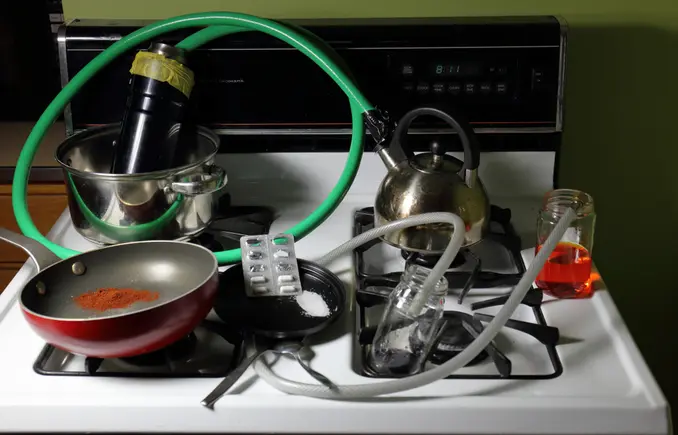The Dangers of Smoking Meth
Table of Contents
- The Dangers of Smoking Meth
- The Many Names of Meth
- How to Smoke Meth: And Reasons Why Not To…
- How to Smoke Meth: Start with Sketchy Chemicals
- How to Smoke Meth: Signs of Meth Abuse
- Mental Illness and Meth Use
- Treatment for a Meth Addiction
- Long Term Meth Treatment for Long Term Recovery
- The Dangers of Smoking Meth: Steps to Sobriety
- Proven Treatment Programs for Meth: Found Here
- How To Smoke Meth And The Dangers Of Smoking Meth (FAQ)
Methamphetamine, also known as meth, is a powerful and dangerous stimulant that affects the central nervous system. Meth is a common and, unfortunately, relatively affordable street drug that is notorious for its highly addictive qualities, as well as its euphoric and energetic effects. These effects come with a steep cost in terms of dependence and damage done during addiction.
In fact, meth is considered to be one of the most addictive drugs throughout the world. ‘How to Smoke Meth & the Dangers of Smoking Meth’ presents both the realities and risks involved in methamphetamines.

Before its switch to the streets and black market, methamphetamine was originally developed in the 20th century from its parent drug — amphetamine. During this time, it was primarily used in nasal decongestants and inhalers, but amphetamines can also be found in certain medicines that treat ADHD (Attention Deficit Hyperactivity Disorder) and narcolepsy.
The Many Names of Meth
However, it’s important to note that amphetamine and methamphetamine do differ, as meth is far more potent and widely misused. Now, anyone can find meth on the streets under its various pseudonyms like Ice, Crystal, and Crank. Meth also comes in a variety of forms like crystal and powder and can range in color — white, ivory, orange, and pink. In its chemically purest form, meth can take on a light blue hue.
The abuse of meth in any form and any quantity can have life-altering effects on users and their brain function. Not to mention, long-term use of this illicit drug can result in a plethora of health deficits like high pressure, stroke, liver damage, kidney damage, delusions, hallucinations, and prolonged paranoia. It’s important to understand the widespread dangers of meth before experimenting with this potent drug.
How to Smoke Meth: And Reasons Why Not To…
Meth is typically cooked in makeshift labs that range from empty warehouses to neighborhood basements. While meth can have a precise cooking method and chemical composite, more often than not, it’s made haphazardly with a slew of toxic chemicals, including:
- Acetone
- Fertilizer
- Ether
- Decongestants i.e., Sudafed
- Lithium
- Hydrochloric acid
- Iodine
- Ammonia
Like many other illegal drugs, meth can be laced with other dangerous substances like fentanyl. When buying it off the streets, users take the risk of purchasing tainted meth from dealers.
Once it’s cooked, meth can be consumed in many different ways, as its most common form of ingestion is through smoking. In fact, many individuals addicted to this dangerous drug find the best way to smoke meth is with a pipe, also known as a ‘pookie’ or ‘flute.’
However, meth can be smoked without a pipe, as many users admit to smoking meth on foil or out of other makeshift objects. Those who choose not to smoke it can also snort, inject, or take meth pills.
How to Smoke Meth: Start with Sketchy Chemicals

Due to its hydrochloric composition, methamphetamine can be smoked by itself without the need to add any other substances to it to change its form. With localized heat, meth can be reduced to a gaseous form where it’s inhaled into the lungs.
In its gaseous state, the meth then enters the bloodstream through the lungs and provides the user with an immediate and intense high. Its nearly instantaneous euphoric effects are why many users appeal to this method of use. After the initial rush, users often feel the effects of the meth for up to 12 hours after.
While there are different ways to smoke meth, the end results are almost always the same — addiction, infections, and overdoses. Continued abuse of meth is known to cause a variety of health problems. However, physically smoking the drug can result in a variety of problems and infections of its own.
The abuse of meth via smoking can cause lesions and burns in the mouth, gums, lips, and inside cheeks. Smoking meth can also lead to severe dental decay, which is commonly referred to as meth mouth. Since the drug attacks the central nervous system, many users’ pain receptors are completely damaged, which makes it hard for them to feel pain. As a result, many don’t feel the rot and the decay from meth mouth.
How to Smoke Meth: Signs of Meth Abuse

As mentioned before, there’s a wide variety of ways to smoke meth and ingest it. As a result, there are numerous devices, tools, and objects that those addicted to meth use to help them absorb the drug. These objects are a clear sign of meth abuse; therefore, if you suspect a loved one of using this powerfully addicting drug, here are some of the items you’ll want to be on the lookout for:
- Hollowed-out ink pens
- Rolled up paper or money
- Foil squares
- Glass pipes or bongs
- Steel wool
- Altered plastic bottles
- Altered light bulbs
- Spoons with burn marks on the base
- Miscellaneous lighters around their place
- Vaping devices
- Dab rigs
If you find any of the above objects in your loved one’s home, this could be a sign that they are using meth. However, some individuals with addiction are experts at hiding any drug paraphernalia they own in order to evade potential inquisition from family and friends. If that’s the case, then it’s also important to be aware of the physical signs and associated side effects of meth abuse. Some short-term side effects to keep an eye out for are:
- High and erratic energy
- Uncontrollable movements
- Constant teeth grinding
- Dilated pupils
- Chills
- Altered moods
- Anxiety
- Impaired thinking or confusion
- Itching and scratching
- Lack of appetite
- Excessive weight loss
- Facial sores
As meth abuse continues, one’s symptoms will gradually get worse as their physical appearance and mental capacity begin to deteriorate. Individuals are at higher risk of developing serious and life-long health impairments if overdose and death don’t occur first. Long-term effects of meth use include:
- Permanent impairment of brain function
- Loss of memory
- Violent outbursts
- Rotting of teeth or gums
- Paranoia
- Hallucinations
- Lack of hygiene
- Repeated movements
- Overdose
- Death
- Worsening of mental disorders
- Suicide
Tweaking is another sign of long-term meth use that’s important to be on alert for. Tweaking is when users keep smoking meth to avoid withdrawal symptoms. This means that individuals will use meth every few hours to sustain their high.
As a result, many users will lack sleep — usually between 3 to 15 days. The high levels of meth mixed with sleep deprivation bring forth a heightened batch of symptoms like increased irritability and paranoia, as well as violent behavior, darting eyes, jerky movements, and a quivering voice.
It’s also important to mention that many individuals struggling with meth addiction also experience a significant increase in libido. Since meth targets the brain and central nervous system, its chemical components can stimulate the brain and heighten sexual arousal while boosting levels of adrenaline.
This dangerous factor mixed with lower inhibitions can result in careless behavior and unprotected and inappropriate sexual encounters. Due to this, people who use meth are at a higher risk of developing sexually transmitted diseases. Additionally, those who use meth through injection are also at risk for developing HIV.
Mental Illness and Meth Use

As meth users seek out the euphoric and energizing highs they so desperately need, they fail to think about the consequences that this potent drug has on the mind and body. Specifically, how meth can affect existing mental health disorders. It’s not uncommon for frequent meth users to also suffer from co-occurring mental health problems.
In fact, many individuals struggling with addiction also have pre-existing mental health issues — regardless of the substances they use. However, the extreme physical and psychological symptoms of meth addiction can intensify the manifestation of mental health disorders like depression, anxiety, and bipolar disorder. The more an individual abuses meth, the worse their mental health becomes.
Sadly, those who have a co-occurring mental health disorder and abuse meth tend to have a harder time getting help for their addiction. Or, if they do seek out rehab services, they have a difficult time staying sober if their mental health problems are not getting treated alongside their meth addiction.
For those who are struggling with meth addiction or have a loved one who is, it’s imperative to understand the deep impact meth has on mental illness, as this will determine the type of treatment that is needed to address both issues.
Treatment for a Meth Addiction

Treatment for meth addiction is a long and arduous process, but one that reaps the beautiful rewards of health and sobriety. The first and most important step to sobriety from meth addiction is admitting your problem and wanting the help and support necessary to seek treatment. Once you have your heart set on creating a new life for yourself, your journey to recovery begins.
Recovering from meth addiction needs to begin with a full-scale detox in order to purge any presence of meth from the body thoroughly. Over time, this will help their bodies regain their natural capacity and get used to functioning without the need for meth.
Many reputable recovery centers will also work on helping patients rehabilitate their minds from the psychological damage that was done by the meth. Like the body, it’s imperative to teach the mind that it can grow and function in everyday life without meth.
It’s important to note, that the process of both detoxing from meth and recovering from meth addiction varies in intensity from person to person. It truly depends on the individual’s level of addiction and willingness to recover.
In some cases where addiction is on the milder side — due to short duration and a small quantity of use — those individuals may qualify for a less intense rehabilitation program like outpatient rehab. Outpatient programs allow patients to detox and recover from the comfort of their homes. While they are required to attend treatment on a weekly basis, they can do so while maintaining their daily routine.
Long Term Meth Treatment for Long Term Recovery
For more severe cases of meth addiction, it’s recommended to attend an inpatient treatment facility that offers detox services. Here, the facility’s medical professionals can properly monitor patients during the detox and withdrawal process to ensure maximum safety and efficiency.
Inpatient treatment is also ideal for individuals whose home environment is not conducive to recovery. Staff members work hard to provide the support that each patient needs while providing them with a place of recovery that is removed from the triggers that cause these patients to use meth.
Most importantly, inpatient programs are usually equipped to treat not only addiction but any co-occurring mental health disorders as well. This is commonly referred to as Dual Diagnosis Treatment, as it’s one of the more specialized areas of addiction rehabilitation.
Therapy is another essential component of treatment that is critical for individuals who are trying hard to break free from their meth addiction. Many of these sessions will range from one-on-one to group therapy and will help provide the tools these individuals need to cope with their triggers and temptations.
Additionally, these therapy sessions will also help patients gain a better understanding of why they use drugs in the first place and how they can work on their behavioral patterns and healthy thought processes.
Together, detoxification, therapy, counseling, and appropriate levels of aftercare planning make for a promising and lasting recovery.
The Dangers of Smoking Meth: Steps to Sobriety

Do you struggle with an addiction to meth? Are you tired of letting your dependency on this potent substance have full control over your life? It may seem like meth is at the front wheel, but you have the power to say when enough is enough. All you have to do is admit that you need help, and the rest will follow.
At Find Addiction Rehabs, we are here to help you on your journey to sobriety. Our team of seasoned professionals is ready and willing to assist you with these important next steps, as our services are available 24/7. Everything may seem very overwhelming at first, but we are here to help you find confidence and empowerment in your decision to get sober.
Proven Treatment Programs for Meth: Found Here
Since recovery looks different for everyone, it’s imperative that you have a treatment plan that is tailored to your specific needs. Luckily, the experts at Find Addiction Rehabs work with a nationwide database of high-quality and reputable addiction treatment centers that specialize in a variety of services. If you’re looking for a safe space to detox in, we can locate a facility that offers detoxing and withdrawal services in addition to treatment.
Recovery is right around the corner — let Find Addiction Rehabs show you the way. Give us a call today for more information on recovery from meth addiction!
How To Smoke Meth And The Dangers Of Smoking Meth (FAQ)
Why is meth so addictive?
The drug causes a surge of dopamine, a chemical that activates the brain’s reward system. The surge of dopamine associated with meth use is the primary reason many people fall victim to the substance and become dependent. Dopamine is a potent chemical, and the desperate search for that surge can be a powerful motivator for humans.
What are the most significant risks associated with a meth addiction?
Meth causes severe dehydration, leading to physical exhaustion and an increased risk of kidney failure. Meth causes an increase in norepinephrine. When released repeatedly without any time for recovery, it wears out neurons and makes them less sensitive to dopamine.
Eventually, your brain no longer produces enough dopamine, making it more likely to cause brain cells to die off completely (a condition called apoptosis)
How easy is it to overdose on meth?
According to the National Institute on Drug Abuse (NIDA), methamphetamine can damage brain cells and trigger strokes or heart attacks at high doses or when combined with other drugs like alcohol or cocaine.
You may experience psychotic episodes with hallucinations and delusions lasting up to six months after ceasing use.
How difficult is meth addiction withdrawal?
The severity of meth withdrawal symptoms depends on how long and frequently you’ve been using meth before quitting. After the drug’s last use, users experience withdrawal symptoms that begin within 12 hours and peak around four days into their abstinence.
Eric R. hails from Maine and does extensive work in the field of behavioral health as both a professional writer and passionate advocate for those suffering. From his own personal encounters with mental illness, he speaks to those seeking healthy relief from depression and anxiety and embraces wellness both personally and professionally. After losing friends and family to the darkness of suicide, Eric aims to educate and inform about the nature of treatment and render it accessible for all those seeking a way out of darkness and despair.

